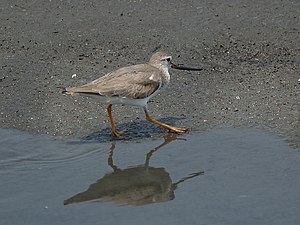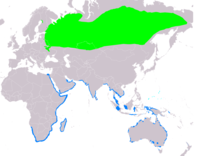Terek sandpiper
| Terek sandpiper | ||||||||
|---|---|---|---|---|---|---|---|---|

Terek sandpiper ( Xenus cinereus ) |
||||||||
| Systematics | ||||||||
|
||||||||
| Scientific name of the genus | ||||||||
| Xenus | ||||||||
| Kaup , 1829 | ||||||||
| Scientific name of the species | ||||||||
| Xenus cinereus | ||||||||
| ( Güldenstädt , 1775) |
The Terek sandpiper ( Xenus cinereus ) is the only species of the genus Xenus Kaup among the snipe birds , 1829. It is a breeding bird of the boreal zone from the east of the Baltic to eastern Siberia. Some isolated breeding sites can also be found in western Russia and in the north of the Gulf of Bothnia. In Central Europe he can occasionally be observed as a stray visitor. In Mecklenburg-Western Pomerania and Schleswig-Holstein, for example, it has been seen every year since the mid-1990s.
features
The 22 to 25 centimeter long Terek water strider reaches a wingspan of 38 to 40 centimeters and is therefore about the same size as the wood sandpiper, but has shorter, yellow to orange legs. The beak is longer and slightly curved upwards. It is black and tinted dull red at the roots in a magnificent dress. The top and the chest are gray-brown in color, the underside is white. In its magnificent dress, the bird has black vertical stripes on its shoulders. When excited, he rocks his back.
The most common call, usually made in flight, is a soft, fluting hühühü , usually two- to three-syllable, sometimes also five-syllable. In addition, the species has a wide repertoire of other, mostly trilling calls. The singing is a repeated three-syllable trill that sounds something like dlü-rrri-rüh .
Occurrence
The Terek Sandpiper breeds in swamps and bogs in the boreal zone of the eastern and central Palearctic from the Kamchatka Peninsula to the northeast of the White Sea . In some regions, its breeding area extends into the subarctic tundra or reaches the edge of the steppe zone in a southerly direction. In Scandinavia it breeds in the Gulf of Finland and Bothnia and in the eastern part of Finland in northern Norway. The Terek sandpiper is a long-distance migrant and migrates to the tropical coasts of Africa, South Asia and Australia to hibernate. He covers distances of 12,000 km and more. The withdrawal from the breeding grounds begins gradually from the beginning of July and ends with the departure of the young birds in September. In the same month, the first wintering Terek sandpipers arrive in southern Africa. The move home will start at the end of March. The birds reach their breeding grounds in late May and early June. Latecomers can be seen in Central Europe until June. In Africa there are also regular summer birds.
behavior
The Terek sandpiper eats insects, worms and snails, which it searches for wading in the shallow water with its long beak. It finds its food either on the surface or by poking deep into the moist substrate. While foraging for food, he often walks briskly with short, jerky-looking steps, short sprints, and sudden turns. He locates most of his prey visually. It is snatched out of the mud with its beak held almost horizontally.
The shallow nesting trough is created in a recess in the open ground or in low vegetation and padded with some parts of plants. The clutch consists of two to five eggs. The eggs are top-shaped, light brown to light rust brown with black brown to purple gray spots and small splashes. Laying begins at the end of May. The incubation period is 23 days. Terek sandpipers belong to the species which show a strongly developed temptation during the breeding and the guidance of the young birds . The seductive parent bird either pretends to be injured or shows behavior in which it flies a short distance, lands and utters chick-like whistling sounds, ruffling its feathers and stretching its neck.
Duration
The European breeding population was estimated at 15,000 to 81,000 breeding pairs at the beginning of the 21st century. Most of the stocks live in the European part of Russia. There are also very small populations in Finland (15 to 20 breeding pairs), Belarus (100 to 150 breeding pairs), Ukraine (300 to 500 breeding pairs) and Latvia (up to a maximum of ten breeding pairs).
Like many other snipe birds, the Terek sandpiper is one of the species that will be particularly affected by climate change. A research team that, on behalf of the British Environmental Protection Agency and the Royal Society for the Protection of Birds, examined the future development of the distribution of European breeding birds on the basis of climate models, assumes that by the end of the 21st century the range of the Terek sandpiper will shrink and become considerably will move east. Today's breeding sites in Ukraine and in western Russia no longer offer the species suitable habitats.
literature
- Hans-Günther Bauer, Einhard Bezzel and Wolfgang Fiedler (eds.): The compendium of birds in Central Europe: Everything about biology, endangerment and protection. Volume 1: Nonpasseriformes - non-sparrow birds. Aula-Verlag Wiebelsheim, Wiesbaden 2005, ISBN 3-89104-647-2 .
- Simon Delany, Derek Scott, Tim Dodman, David Stroud (Eds.): An Atlas of Wader Populations in Africa and Western Eurasia. Wetlands International , Wageningen 2009, ISBN 978-90-5882-047-1 .
- Peter Colston, Philip Burton: Limicolen - All European wader species, identifiers, flight images, biology, distribution. BlV Verlagsgesellschaft, Munich 1989, ISBN 3-405-13647-4
- Anne Puchta, Klaus Richarz: Steinbach's great bird guide. , Eugen Ulmer Verlag 2006, ISBN 3-8001-4490-5
- Bergmann, Helb, Baumann: The voices of the birds of Europe. , Aula Verlag 2008, ISBN 978-3-89104-710-1
Web links
- Terek sandpiper on birdsinbackyards
- Xenus cinereus in the endangered Red List species the IUCN 2008. Posted by: BirdLife International, 2008. Accessed January 31 of 2009.
- Videos, photos and sound recordings for Xenus cinereus in the Internet Bird Collection
- Terek sandpiper's feathers
Individual evidence
- ↑ Bauer et al., P. 497
- ↑ Colston et al., Pp: 204
- ↑ Delany et al., S: 345
- ↑ Bauer et al., P. 497
- ↑ Colston et al., P. 205
- ↑ Bauer et al., P. 497
- ^ Brian Huntley, Rhys E. Green, Yvonne C. Collingham, Stephen G. Willis: A Climatic Atlas of European Breeding Birds , Durham University, The RSPB and Lynx Editions, Barcelona 2007, ISBN 978-84-96553-14-9 , S. yy


